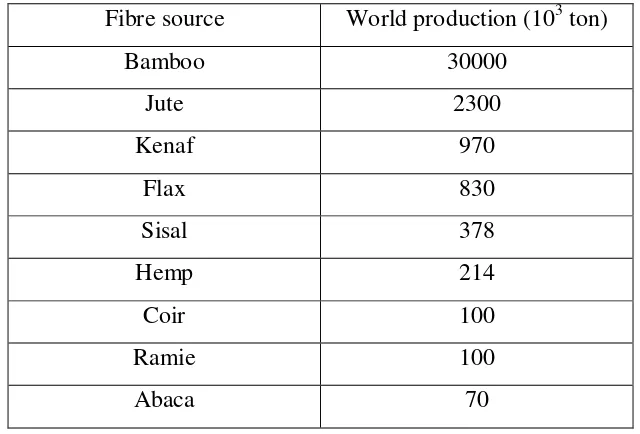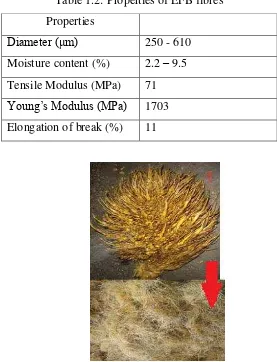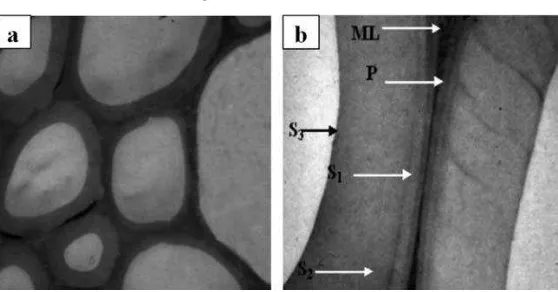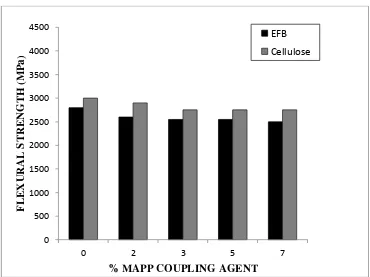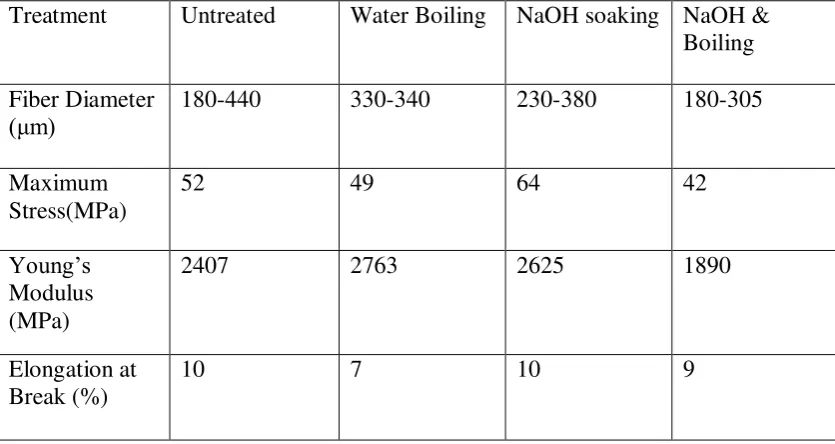SUPERVISOR DECLARATION
“I hereby declare that I have read this thesis and in my opinion this report is sufficient in terms of scope and quality for the award of the degree of Bachelor of Mechanical
Engineering (Thermal-Fluids)”
Signature : ………
Supervisor : DR. SIVAKUMAR DHAR MALINGAM
MODELLING OF PALM FIBRE POLYPROPYLENE COMPOSITE FOR RANDOMLY DISTRIBUTED FIBRE REINFORCEMENT
YUVARAJAN A/L KARATHIHAYAN
ii
DECLARATION
“ I hereby declare that the work in this report is my own except for summaries and quotations which have been duly acknowledged.”
Signature : ………..……….
Author : YUVARAJAN A/L KARATHIHAYAN
iii
Specially dedicated
iv
ACKNOWLEDGMENT
Praise to God almighty for His grace in providing me the strength and ability in bringing this research to completion.
I would like to extend my sincere gratitude and appreciation to my project supervisor, Dr.Sivakumar Dhar Malingam, for his devotion and effort in providing me with the guidance needed to accomplish this research.
v
ABSTRACT
vi
ABSTRAK
Kajian ini membentangkan pembangunan model Analisis Unsur Terhingga
vii
TABLE OF CONTENTS
CHAPTER CONTENTS PAGE
DECLARATION ii
CHAPTER 1 INTRODUCTION 1
1.0 Introduction 1
2.2 Polypropylene composites 6
2.3 Fibre loading in composite 7
2.4 Coupling agents 9
2.5 Alkaline treatment 11
2.6 Finite element analysis 12
2.6.1 Material models 14
viii
4.1 Modelling material behaviour 27
4.1.1 Material Behaviour and Material Model
4.2 Tensile simulation results corellation with experimental results
33
ix
4.2.4 Tensile Simulation Using Plane 182 39
CHAPTER 5 DISCUSSION 40
5.0 Introduction 40
5.1 Comparisons between shell 181 and shell 281 40
5.2 Comparisons between solid 185 and plane 182 43
5.3 Comparisons between shell 181 and plane 182 44 5.3 Effect of varrying poisson’s ratio in simulation 45
CHAPTER 6 CONCLUSION & RECOMMENDATION 47
6.0 Conclusion 47
6.1 Recommendation 48
x
LIST OF TABLE
NO. TITLE PAGE
1.1 Commercially available fibre source 2
1.2 Properties of EFB fibres 3
2.1 Mechanical properties of treated and untreated fibres 11
2.2 Material models used to model polypropylene 14
3.1 Composition of fibre, PP and MAPP during session of mixing 18
4.1 Values of Modulus of Elasticity and Poisson’s Ration for
ANSYS input. 30
4.2 True values of Stress-Strain Point to be used in material model. 31 4.3 The Results of the mesh sensitivity study of corresponding
element numbers for shell type elements 32 4.4 The Results of the mesh sensitivity study of corresponding
element numbers for solid type elements. 32 5.1 Computation time taken by elements for a convergence
in solution 41
5.2 Computation time taken by elements for a convergence
xi
LIST OF FIGURES
NO TITLE PAGE
1.1 Empty fruit bunch and the processed fibre 3 2.1 Arrangement of lignin, cellulose, and Hemicellulose 6 2.2 Transverse section of OPEFB fibre cell wall 6 2.3 Effect of MAPP on composite tensile strength at 30%wt filler
loading
10
2.4 Effect of MAPP on composite flexural modulus at 30%wt filler loading
10
2.5 The three models developed by Homayonifar and Zebarjad 13
3.1 Chopped oil palm empty fruit bunch 16
3.2 Process flow of sample preparation 16
3.3 EFB fibres being treated in 2% of NaOH solution 17
3.4 Crusher Machine 18
3.5 Internal mixer machine 19
3.6 Mixture in pellets form 19
3.7 Mould which is made up of three layers 20
3.8 Hot and cold press machine 20
3.9 Dimensions for the tensile specimen according to ASTM 3039/3039M
21
3.10 Tensile Test Machine (Model: Instron 5585) 22 3.11 Flowchart for FEA process in the research 23
3.12 Quadratic element for meshing 24
3.13 Tensile FEA model after pre-processing done 25 4.1 Samples cut from different orientations from composite sheet 28 4.2 Tensile Stress-Strain graph from tensile test 29 4.3 Comparison between Engineering stress-strain values from
experiment and converted True values for material model input.
xii
4.4 The FEA problem setup for the mesh sensitivity study conducted 33 4.5 Geometry of elements used in the study, Shell 181 (a), Shell 281(b),
Solid 185 (c), and Planar 182 (d)
35
4.6 The tensile simulation using Shell181 element compared to experimental results
36
4.7 The tensile simulation using Shell 281 element compared to experimental results.
37
4.8 The tensile simulation using Shell 281 element compared to experimental results.
38
4.9 The tensile simulation using Plane 182 element compared to
experimental results.
39
5.1 Comparison of tensile simulation results of shell element and experiment
40
5.2 Von Mises equivalent Stress generated using the shell 181 element 42
5.3 Comparison of tensile simulation results of solid elements and experiment.
43
5.4 Comparison of tensile simulation results of solid elements, shell elements and experiment
44
5.5 Stress strain curves obtained from different values of Poisson’s Ratio using the Shell 181 element.
45
5.6 Stress strain curves obtained from different values of Poisson’s Ratio using the Plane 182 element
1
CHAPTER 1
INTRODUCTION
1.0 INTRODUCTION
With the problem of environment and sustainability at large, there has been many developments of green technology where the field of material science and engineering has been developing biocomposites to play its part. Biocomposites as materials are coupled with natural resources have seen increasing research interest. Biocomposites poses a challenge where the many combinations of materials offer a wide variety of properties as well as characteristics. The characteristics and properties of biocomposites vary typically due to the influence of natural fibres type, the effect of environmental conditions where the fibres are sourced, the methods involved in treating the fibres and the alterations made to the fibre matrix.
The scarce availability of non-renewable resources has made a tremendous impact on the dependence of renewable resources. The emergence of products based on renewable plants has surged in recent times. Natural fibres are sourced from
2
Table 1.1: Commercially available fibre source
Fibre source World production (103 ton)
Bamboo 30000
Utilisation of natural fibres in modern engineering provides advantages such as low weight, low density, recyclability and biodegradability (Khalid et.al 2008) which allows for a better way of managing these biofillers. Natural fibres on their own possess mechanical properties that can justify their utilisation for much application. However by coupling them with plastics which exhibit high plasticity load bearing applications could be applicable.
In Malaysia oil palm empty fruit bunch (EFB) which is the waste product of palm oil processing of almost 30 million tonnes per year is abundantly available (Hassan et al.1997). Recent researches involving utilisation of EFB as reinforcement matrix in polymers have been conducted in which the mechanical properties were studied (Yusoff et al.2010). These studies were done by altering the preparation of the fibre and its matrix (Arbelaiz et al.2005).EFB bio-composites are assessed on
their mechanical properties through tensile tests and flexural tests (Yusoff et al.2010). Studies regarding the effect of chemical modification on mechanical properties (Rozman et al.2003) and also hybrid bio-composites (Jawaid et al.2012) were also done. EFB fibres are produced from the fruit bunch of oil palm they are
3
Table 1.2: Properties of EFB fibres
Properties
Diameter (μm) 250 - 610
Moisture content (%) 2.2 – 9.5
Tensile Modulus (MPa) 71 Young’s Modulus (MPa) 1703 Elongation of break (%) 11
Figure 1.1: Empty fruit bunch and the processed fibre (Rozman et al.2003)
4
1.1 PROBLEM STATEMENT
The large waste of by-products such as bio-mass, fronds, and empty fruit bunch (Rozman et al.2003) are produced every day. In an effort to diversify the use of by-products, fibres produced from empty fruit bunch (EFB) is currently undergoing extensive research ,as this fibre can be used as a replacement for non-organic composite fillers in polymer composites. Many researches had been done on the structural performance of EFB fibre reinforced epoxy (Yusoff et al.2010) and EFB reinforced Polypropylene (Rozman et al.2003) but these have only consisted of mechanical testing and there is still lack of FEA modelling done in order to determine the performance of these structures. FEA modelling allows reduction in
terms of research and time consumption besides fewer experiments are required to be conducted. Moreover FEA model will also be able to show the distribution of stress and strain of a final product during the design stage. Hence FEA model has to be developed in order to aid researches on natural fibre reinforced composite
1.2 OBJECTIVES
The goal of this research in order to solve the problem statement given previously is to model a suitable finite element model in order to study stress distribution in discontinuous fibre arrangement in polypropylene. The major concern of the research is the correlation of data gathered from the experiment and the data produced by the FE analysis.
The objectives of the research are:
1. To develop a finite element model using finite element software.
2. To simulate and examine the stress distribution using finite element software.
3. To validate the finite element model with experimental work.
1.3 SCOPE
5
CHAPTER 2
LITERATURE REVIEW
2.0 INTRODUCTION
This literature study emphasises on the review of structural performance of
oil palm EFB fibre composite materials, specifically the tensile properties of the composite. Studies regarding finite element analysis (FEA) validated by experimental work carried out by researchers globally are reviewed. Besides that, scholarly work in relation to the preparation and treatment of fibre as well as
standards used in mechanical testings are reviewed
2.1 OIL PALM EMPTY FRUIT BUNCH FIBRE
Oil palm empty fruit bunch fibre (OPEFB) also called lignocellulose fibres are composed of cellulose and hemicellulose in a lignin matrix as shown in figure 2.1. The compositions of lignin, cellulose and hemicellulose differ from breeds of oil palm, soil and plantation location. The mechanical properties which attribute the oil palm fibre such as tensile strength, flexural strengths, and rigidity are dependent on the alignment of the cellulose fibrils (John and Thomas, 2008). Cellulosic fibrils align themselves parallel to each other and form crystalline structure and a small
quantity of amorphous regions. Figure 2.2 shows the transverse cross section of OPEFB fibre cell wall structure. The OPEFB fibre consists of two main walls, the secondary wall consists of three sub-secondary (S1, S2, and S3) wall layers where the layers consist of different cellulose fibril orientation (Khalil et al.2006).OPEFB
6
Figure 2.1: Arrangement of lignin, cellulose, and Hemicellulose (Source:http://lignofuel.wordpress.com)
Figure 2.2: Transverse section of OPEFB fibre cell wall structure (ML, middle
lamella; P, primary wall; S1, S2, and S3, secondary wall sub layers)(Source: Hassan
et al.2010)
2.2 POLYPROPYLENE COMPOSITES
Polypropylene is used widely due to its properties such as low density, good surface hardness, and good mechanical properties (Perez et al.2012). However polypropylene (PP) alone is not sufficient for applications that require high stiffness and mechanical strength. In order to overcome these insufficiencies polypropylene
based composites gained interest and is commonly used in home appliances, automotive industry and other industries. The mechanical properties of the composites especially those composites reinforced with natural fibre still lack good data of their mechanical properties (Perez et al.2012). Glass fibre reinforced
7
nanotube reinforced polypropylene composites are some of the common composites of polypropylene with inorganic fillers. Research on these composites have been done on their mechanical properties such as Mariana an Silvia (2012) who have studied the effect of enhancing adhesion between the glass fibre and the PP matrix on the mechanical properties of the composite. Rahmanian et al.(2012) conducted study on the effect on tensile strength, flexural strength and impact properties of carbon nanotube coated glass and carbon fibre reinforced polypropylene composite. Natural fibre reinforced polypropylene has properties which make it important as a renewable and environmentally friendly substitute to non-organic fillers such as glass fibres and carbon fibres. Natural fibres are low in cost, biodegradable, have low density and have high specific strength (Pankaj et al.2012). Tensile and fracture
behaviour of PP and wood flour (WF) composite was conducted by Ezequeil et al (2012). In the experiment, samples with different weight content of wood flour were produced. Tensile test conducted showed that the pure PP composite was far more superior having higher tensile strength compared to PP/WF composites which had
failed at a lower tensile strength. Besides, the tensile strength reduces as the weight content of WF increases.
Comparative studies between oil palm empty fruit bunch (OPEFB) fibre and oil palm derived cellulose in their mechanical studies have been carried out by Khalid et al. (2008) In the study tensile strength, flexural strength and impact strength of both fibre and cellulose filled PP in different loading contents were compared, where the study showed that PP has decreasing if not the same tensile strength when loaded with the fibre and cellulose.
2.3 FIBRE LOADING IN COMPOSITES
Short discontinuous fibres are usually produced by adding certain amount of fibres into the matrix, where any amount of fibre loading other than the specific fibre content will lead to detrimental effects on the mechanical properties of the composite. Fibre loading refers to the volume fraction or weight fraction of the fibre
8
Weight fraction of the fibre is given is by the weight of fibres to the sum of weight of both fibre and matrix.
W
T= Weight of total fibre and matrix compositionW
f=Weight of fibre contentW
m= Weight of matrix contentThe Volume fraction of fibres can be found from the weight fraction of the sample. The equations for the conversion are given by;
mDensity of the matrix, in the case of polypropylene is given by Rozman et
al.(2003) as 0.903 g/cm3
W
f= Weight of fibre contentW
m= Weight of matrix contentIn the work by Ramli et al. 2011 study of the effect of fibre loading and coupling agents on mechanical, thermal and interfacial properties were done. From
9
2.4 COUPLING AGENT
Coupling agent allows for a better adhesion between fibre and the PP matrix. In many research involving the investigation of mechanical properties of natural fibre reinforced PP or other polymers, coupling agents such as meleated polypropylene (MAPP) and maleic anhydride (MAH) are used. The MAH is present also in MAPP. The methodology involving the use of these coupling agents differs in the sense of interchanging the components (MAH< MAPP) to treat composite. When the fibres are treated with a coupling agent, the MAH is used and should the PP is to be treated or grafted as the process is named then MAPP is used. MAH reacts with the lignocellulosic hydroxyl group making them form a covalent bond
with the polar acid base in PP. In a study conducted by Rozman et al (2003) studies were carried out to investigate the effects of MAH as the coupling agent on various fibre weight gain in EFB fibre reinforced with PP composite. The weight gains in the fibres are caused by absorption of maleic anhydride by the fibres thus it is analogous
to higher percentage of weight gain means higher amount of MAH used. The result of the study in respect to flexural test concludes that the 20% weight gain of fibre at all filler size (mesh 60, mesh 80and mesh 120) offers the best flexural strength to the composite.
MAPP is produced by grafting MAH and PP by using peroxides at desirable temperatures and is applied as a coupling agent in composites by adding a certain mechanical properties of EFB fibre and cellulose polypropylene composite (shown
as Cellulose in Figure 2.3 and Figure 2.4) was carried out. The research was carried out by using samples with 30% weight fibre and cellulose weight loading with variable MAPP content on mechanical tests. Figure 2.3 and Figure 2.4 show the results from the tensile and flexural test respectively, it can be concluded that 2%
10
Figure 2.3: Effect of MAPP on composite tensile strength at 30%wt filler loading (Khalid et al. 2006).
11
2.5 ALKALINE TREATMENT
Alkaline treatment is done on fibres in order to create better compatibility with the PP matrix. In the work of Bedzki and Gassan (1999) alkaline treatment towards cellulose based reinforcement in thermoplastics was done. It was found that removal of lignin and hemicellulose improved the tensile characteristics of the fibre due to the capability of fibrils arranging themselves better for stress distribution of tensile stress. The alkaline treatment also increases the surface roughness of the fibre which improves the mechanical bonding. (Asumani et al.2012) In the works of Bachtiar et al.(2010) the flexural strength was improved compared to untreated fibre by immersing the sugar palm fibre in a solution of 2.5% NaOH for 1 hour. Izani et
al.(2012) treated oil palm EFB fibre with 2% NaOH by immersing the fibres in the solution for 30 minutes, treatment by boiling in hot water for 30 minutes and also did a combination treatment by immersing the fibre in 2% NaOH and then boiling the fibres in hot water for another 30 minutes. The study concluded that soaking in
NaOH for 30 minutes had favourable tensile strength compared to other treatment methods. Table 2.1 shows the summary of mechanical properties before and after the treatment.
Table 2.1: Mechanical properties of treated and untreated fibres (Izani et al.2012)
